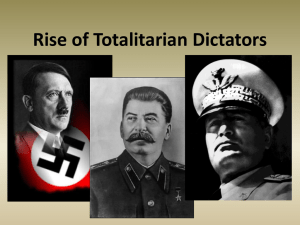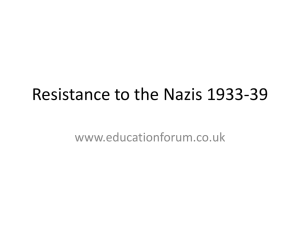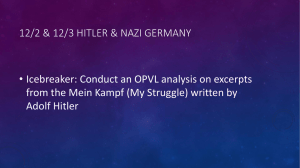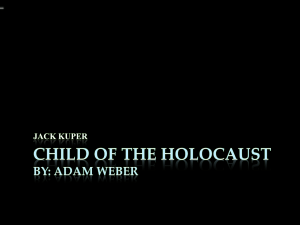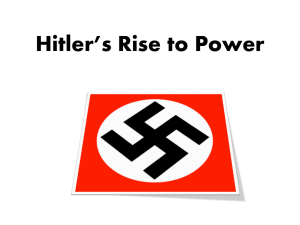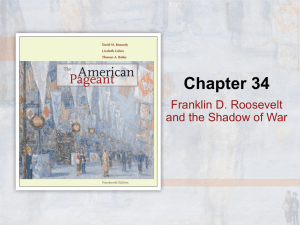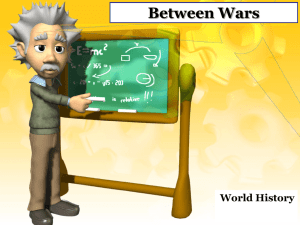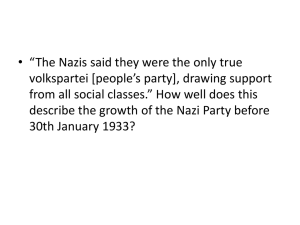2. Web – A2 GCE Hist 6HI03 – Rise of the Nazis
advertisement
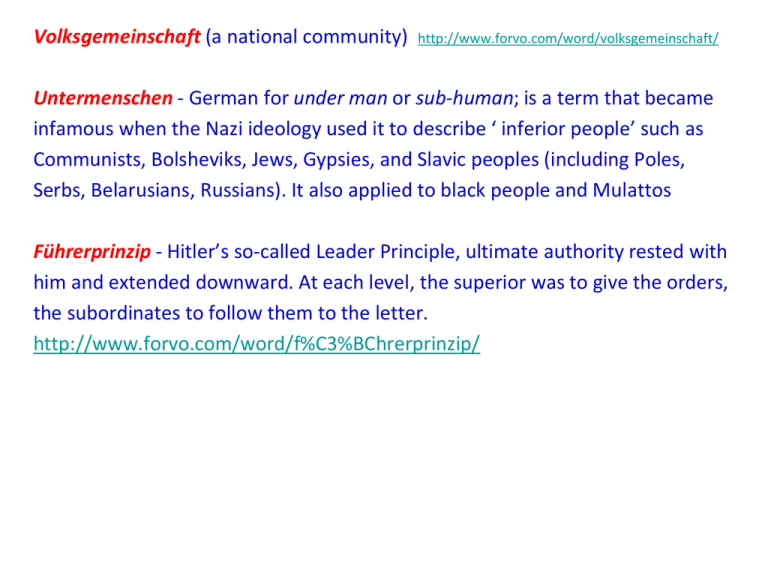
Volksgemeinschaft (a national community) http://www.forvo.com/word/volksgemeinschaft/ Untermenschen - German for under man or sub-human; is a term that became infamous when the Nazi ideology used it to describe ‘ inferior people’ such as Communists, Bolsheviks, Jews, Gypsies, and Slavic peoples (including Poles, Serbs, Belarusians, Russians). It also applied to black people and Mulattos Führerprinzip - Hitler’s so-called Leader Principle, ultimate authority rested with him and extended downward. At each level, the superior was to give the orders, the subordinates to follow them to the letter. http://www.forvo.com/word/f%C3%BChrerprinzip/ TOPIC: Intro to Rise of the Nazis - Origins to 1928 OBJECTIVES: 1. Describe how support for the Nazis grew in the late 1920s and early 1930s. KNOWLEDGE DEVELOPMENT: 1. Fascism - a form of aggressive and racist nationalism, combining militarism with a strong authoritarian leader to impose order on society. • Belief that the nation is more important than the individual • A nation became great by expanding its territory and building up its military • Fascist governments control every aspect of life (education, media and even sports) and forced people to put the needs of the country first. • It is considered anti-democratic and anti-socialist. • Unlike Communism, Fascism didn’t believe in equality, instead believing that men were superior and Aryan Germans a superior race. KD: Sources A, B, C on p. 114 - 115, main message / intimidation affect: This Nazi poster from the 1928 election reads ‘Break the Dawes chains’. TOPIC: Intro to Rise of the Nazis - Origins to 1928 OBJECTIVES: 1. Describe how support for the Nazis grew in the late 1920s and early 1930s. KD ANSWERS: 3. DAP and NSDAP : p. 115 • National Socialist German Workers' Party (German: Nationalsozialistische Deutsche Arbeiterpartei, abbreviated NSDAP, commonly known as the Nazi Party • It was a political party in Germany, founded in January, 1919 by Anton Drexler. Hitler infiltrated it as a V-Man in 1919 and took control of it in 1921 as it’s Führer. • It’s predecessor, the German Workers' Party (DAP). 4. Twenty-Five Point Programme called for: p. 115 • Presented in February 1920, it was a manifesto written by Anton Drexler and Adolf Hitler. • It called for revising TOV, ending reparations, Lebensraum, Volksgemeinschaft (a national community); and anti-Semitism. http://www.forvo.com/word/volksgemeinschaft/ German Workers’ Party (DAP) in 1919: • Hitler made speeches and wrote articles in local papers about the party’s beliefs and ideas for a better Germany. • He spoke passionately about Germany and the need for good leaders, who would get revenge for Germany’s defeat in WWI. • By 1921 he was running the party and changes its name to the National Socialist German Workers’ Party (Nazi Party) • He made the Swastika the Nazi symbol and used ‘Brown Shirts’ to beat up opponents. National Socialist German Workers' Party (NSDAP), commonly known as the Nazi Party In 1919 Anton Drexler, Gottfried Feder and Dietrich Eckart formed the German Worker's Party (GPW) in Munich. The German Army was worried that it was a left-wing revolutionary group and sent Adolf Hitler, one of its education officers, to spy on the organization. Hitler discovered that the party's political ideas were similar to his own. He approved of Drexler's German nationalism and anti-Semitism but was unimpressed with the way the party was organized. Although there as a spy, Hitler could not restrain himself when a member made a point he disagreed with, and he stood up and made a passionate speech on the subject. http://www.spartacus.schoolnet.co.uk/GERnazi.htm TOPIC: Intro to Rise of the Nazis - Origins to 1928 OBJECTIVES: 1. Describe how support for the Nazis grew in the late 1920s and early 1930s. KNOWLEDGE DEVELOPMENT: 5. Vőlkischer Beobachter translated as ‘People's Observer’ • It was the main official newspaper of the Nazi Party, bought by the NSDAP in December, 1920. • The primary aim of ‘Vőlkischer Beobachter’ was to spread the word of Nazism and to print the propaganda of Joseph Goebbels. • The production of ‘Vőlkischer Beobachter’ ended when Nazi Germany collapsed in May 1945. Pronunciation http://www.forvo.com/word/v%C3%B6lkischer_beobachter/ TOPIC: Intro to Rise of the Nazis - Origins to 1928 OBJECTIVES: 1. Describe how support for the Nazis grew in the late 1920s and early 1930s. KD ANSWERS: 6. Hitler uses the Sturmabteilung: • The SA or Storm Detachment was better known as the • • • • ‘Brownshirts’ or Storm Troopers. It was the paramilitary wing of the Nazi Party. From 1921 to 1933 the SA disrupted the meetings of Hitler’s political opponents as well as defended the halls where Hitler was making speeches. According to the Nuremberg Military Tribunal (1946 - 1949), the SA was made up of “ruffians” and “bullies”. However, it played a very important role in the first years of the Nazi Party. Many of the original members of the SA had opposed the Versailles Treaty, fought the brief Bavarian Soviet and opposed the general weakness of the Weimar government. http://www.forvo.com/word/sturmabteilung/ TOPIC: Intro to Rise of the Nazis - Origins to 1928 OBJECTIVES: 1. Describe how support for the Nazis grew in the late 1920s and early 1930s. KD ANSWERS: 7. The Munich (Beer Hall) Putsch, Nov 8 & 9, 1923: p. 116 • In September 1923, the Chancellor Gustav Stresemann and President Ebert had decided that the only way Germany could proceed after hyperinflation was to agree to work with the French and pay reparations. • The Nazi party had 55,000 members. With the Ruhr Crisis and resentment toward the Weimar government, Hitler and the NSDAP thought they could seize power. • Their aim was to create a dictatorship with renowned General, Erich Ludendorff as its president. 7. The Munich (Beer Hall) Putsch, Nov 8 & 9, 1923: p. 116 • Hitler and 600 of his Stormtroopers (SA) went into the conservative political meeting led by the Bavarian Prime Minister, Gustav Kahr. • These SA men, lead by Ernst Röhm, lined the sides of the hall in an attempt to intimidate those in the beer hall. It is said that Hitler, once on the speaker’s platform, shouted out the following: "The national revolution has broken out. The hall is surrounded." • On November 9th, Hitler started his march with his followers. By the morning he knew that the army and police had been alerted that the Nazis would try to take over vital buildings in Munich. • Hitler hoped to appeal to the army and police to support him. • With war-hero, Luderndorff leading the march, Hitler started the march to the centre of Munich with 3,000 men. • The Nazis were confronted by 100 armed police and soldiers who blocked them. Shots were fired and 16 Nazis and 3 policemen were killed. TOPIC: Intro to Rise of the Nazis - Origins to 1928 OBJECTIVES: 1. Describe how support for the Nazis grew in the late 1920s and early 1930s. KD ANSWERS: 8. In 1924 the NSDAP was outlawed and Hitler went to prison. It turned out to be stroke of good fortune for Hitler. Outline the efforts made to reorganise the Nazi Party in the period called, the ‘Wilderness Years’ . • Hitler was found guilty of treason and sentenced to 5 years in prison. He served from March 1924 until his release on February 27, 1925. • Hitler had time to write Mein Kampf and it gave him a reputation as a man whose ideas might be able to help Germany become great. • Hitler reconsidered his tactics and decided to use the Weimar system with his policy of legality (through elections.) • The Party was reorganised and an index of all members was created. • Hitler persuaded Bavarian Chancellor to lift the ban on the NSDAP in 1925. • The Schutzstaffel (SS) was created as the bodyguard for Hitler in Nov. http://www.forvo.com/word/schutzstaffel/ 8. ‘Wilderness Years’: • At the Bamberg Party Conference in February, 1926, Hitler asserted his ideology and the Führerprinzip. It was a principle that within the Nazi Party, Hitler possessed all power and authority and extended downward. At each level, the superior was to give the orders, the subordinates to follow them to the letter. http://www.forvo.com/word/f%C3%BChrerprinzip/ • Gauleiter (Gaue) - were set up in the 35 electoral districts of Weimar Germany. A regional leader in Nazi Germany would serve as a provincial governor. http://www.forvo.com/search/Gauleiter/ • Hitler attempted to demote the SA. • The disappointment at the ballot box in May 1928 for the Reichstag, acted as a stimulus for further reorganisation. • Hitler tried to target and involve various groups. In 1926 the Hitler Youth and Nazi Students’ Association were established. 8. ‘Wilderness Years’: • By 1928 Nazi, organisations were set up for doctors and teachers. • By 1930, to draw discontented peasants into the movement, Agrar Politischer Apparat (AA - Agricultural Affairs Bureau of the NSDAP) was founded by Walther Darré. http://www.forvo.com/search/Agrar%20Politischer%20Apparat/ 8. ‘Wilderness Years’: • Joseph Goebbels was a German politician and Reich Minister of Propaganda in Nazi Germany from 1933 to 1945. Goebbels was highly efficient at spreading the Nazi message. He and Hitler believed that the best way to reach what they called ‘the masses’ was by appealing to their feelings rather than by rational argument. Goebbels produced posters, leaflets, films and radio broadcasts; he organised rallies; he set up ‘photo opportunities’. • Despite these shifting policies and priorities, there was no electoral breakthrough for the Nazis. Even after all their hard work, in 1928 they were still a fringe minority party who had the support of less than 3% of the population. They were the smallest party with fewer seats (12) than the Communists (54). The prosperity of the Stresemann years and Stresemann’s success in foreign policy made Germans uninterested in extreme politics. TOPIC: Intro to Rise of the Nazis - Origins to 1928 OBJECTIVES: 1. Describe how support for the Nazis grew in the late 1920s and early 1930s. Support for the Nazis and Communists, and unemployment, 1928–32. TOPIC: Intro to Rise of the Nazis - Origins to 1928 OBJECTIVES: 1. Describe how support for the Nazis grew in the late 1920s and early 1930s. • Although their anti-Semitic policies gained them some support, the Nazis failed to win over the workers. Workers with radical political views were more likely to support the Communists. • The majority of workers supported the socialist Social Democratic Party (SPD), as they had done in every election since 1919. • The Nazis found that they gained more support from groups such as the peasant farmers in northern Germany and middle-class shopkeepers and small business people in country towns - who were not sharing in Weimar Germany’s economic prosperity. • The Nazis highlighted the importance of the peasants (35% of population) in their plans for Germany, promising to help agriculture if they came to power. They praised the peasants as racially pure Germans through Nazi propaganda, and portrayed city-dwellers as immoral and corrupted by Jews. TOPIC: Intro to Rise of the Nazis - Origins to 1928 OBJECTIVES: 1. Describe how support for the Nazis grew in the late 1920s and early 1930s. KD: 1. Alfred Hugenberg / DNVP: p. 118 • The German National People's Party (DNVP) was formed in 1919. This right-wing party opposed the TOV and was critical of the power of the trade unions. Led by the wealthy newspaper magnate, Alfred Hugenberg, the DNVP won 66 seats in the Reichstag in the 1920 General Election. This grew to 103 in December, 1924. • The DNVP campaigned against the Locarno Treaty and the Young Plan. However, by 1930 the more extreme Nazi Party became the country's leading right-wing party and by 1933 they only has 52 seats. TOPIC: Intro to Rise of the Nazis - Origins to 1928 OBJECTIVES: 1. Describe how support for the Nazis grew in the late 1920s and early 1930s. A Nazi election poster from 1928, saying ‘Work, freedom and bread! Vote for the National Socialists.’ KD: 3. Wall Street Crash / Depression - focus to the Nazis: • Müller‘s (1928–1930) Grand Coalition fell apart and subsequent governments were minority administrations that lacked Reichstag support - further polarising German politics • Popularity rose for those (Nazis) who offered radical solutions to economic problems (especially to German industry). • Was a ‘trigger’ that helped undermine democracy in Germany. • By 1933 over 6 million Germans were unemployed (33%). The bedrock of growing Nazi support was established in those who thought ‘they might be next’ and lose their job - the Mittlestand (lower middle class). http://www.forvo.com/word/mittelstand/ • The KPD (Communist Party) and SPD (Social Democratic Party) were significantly weakened from 1928 - 1932. • Germans broke with their voting ranks and the Nazis garnered support with their refrain - ‘destroy the TOV.’ TOPIC: Intro to Rise of the Nazis - Origins to 1928 KD: 4. Heinrich Brüning - direction he took Germany: • Chancellor as the government shifted from parliamentary to presidential government. • In July 1930 his Centre Party’s Financial Bill was defeated. Brüning then attempted legislation by decree using Article 48, but was again defeated in the Reichstag. • The Reichspresident, Paul von Hindenburg dissolved the Reichstag and called for an election in Sept. 1930. • The Financial Bill was passed by presidential decree and Wiemar democracy was in danger. TOPIC: Intro to Rise of the Nazis - Origins to 1928 OBJECTIVES: 1. Describe how support for the Nazis grew in the late 1920s and early 1930s. KD: 5. Joseph Goebbels - impact of Nazi election success in 1930: p. 120 • Goebbels was instrumental in the planning and execution of the Nazi electioneering programme. • Elections to the Reichstag rose from 12 seats in 1928 to 107 in 1930 (an increase from 800,000 votes to 6.4 million), second only to SPD/SDP (143). • The 1930 election victory acted as a stimulus for membership. From September to December 1930, nearly 100,000 new members joined the NSDAP, with particular expansion of peasants in the countryside and the Agrar Politischer Apparat (AA). http://www.forvo.com/search/Agrar%20Politischer%20Apparat/ • Hitler further gained ‘legitimacy’ through his crackdown on the more radical party members of the SA, such as Strasser and Stennes in 1931. It helped Hitler by showing that his leadership was committed to ‘LEGALITY’. TOPIC: Intro to Rise of the Nazis - Origins to 1928 OBJECTIVES: 1. Describe how support for the Nazis grew in the late 1920s and early 1930s. A poster for a 1931 midsummer festival organised by the Nazi Party. The poster proclaims ‘Against Versailles’. Table 6.1, p. 121 - Decline of the Reichstag, 1930 - 1932: 6. Suggests - Democracy and the Weimar government: 1930 1931 1932 Days the Reichstag Sat 94 42 13 Laws passed by Reichstag 98 34 5 Emergency Decrees Issued using Article 48 5 44 66 • Democracy was being usurped by Article 48 and presidential decree. There were 44 decrees in 1931 as compared to 5 in 1930. The inability to solve Germany’s economic problems through Parliamentary legislation opened the door to alternative governing methods, ultimately cumulating in ‘legal’ abuse of power … by Hitler. • Political parties represented different interests and were not cooperating. TOPIC: Intro to Rise of the Nazis - Origins to 1928 OBJECTIVES: 1. Describe how support for the Nazis grew in the late 1920s and early 1930s. A Nazi election poster from July 1932. The Nazis proclaim ‘We build!’ and promise to provide work, freedom and bread. They accuse the opposing parties of planning to use terror, corruption, lies and other strategies as the basis for their government. TOPIC: Intro to Rise of the Nazis - Origins to 1928 OBJECTIVES: 1. Describe how support for the Nazis grew in the late 1920s and early 1930s. Paul von Hindenburg was a senior military figure in Germany during World War I and 2nd president of the Weimar Republic (1925 - 1934). Chancellors of Germany, 1925 - 1934: • Hans Luther (1925–1926) • Wilhelm Marx (1926–1928) • Hermann Müller (1928–1930) • Heinrich Brüning (1930–1932) • Franz von Papen (1932) • General Kurt von Schleicher (1932–1933) • Adolf Hitler (1933–1934) TOPIC: Intro to Rise of the Nazis - Origins to 1928 OBJECTIVES: 1. Describe how support for the Nazis grew in the late 1920s and early 1930s. KD: 8. Nazi election success - met with resistance by 1932: p. 122 - 123 • Paul von Hindenburg was re-elected in 1932 with 53% of the vote compared to Hitler’s 36.8%. • Hindenburg instituted the Emergency Decree of April 1932. It banned the SA and SS. TOPIC: Intro to Rise of the Nazis - Origins to 1928 OBJECTIVES: 1. Describe how support for the Nazis grew in the late 1920s and early 1930s. KD: 9. Roles - Franz von Papen and General Kurt von Schleicher played in bringing Hitler to power: p. 122 - 123 • Political in-fighting between Minister of Interior, General Groener and General von Schleicher resulted in a political agreement between Hitler and von Schleicher in May 1932: Hitler accepted a role in the new presidential cabinet. Brüning (1930–1932) was replaced as Chancellor by Franz von Papen and von Schleicher was named Minister of Defense. • A ban was lifted on the SA and SS in June, 1932. In July the Preußenschlag (Prussian coup - http://www.forvo.com/word/preu%C3%9Fenschlag/) took place after clashes during the Bloody Sunday of Altona, Hamburg (July 17). The Communist Rotfrontkämpferbund (Red Front-Fighters) met in street clashes with the SA. TOPIC: Intro to Rise of the Nazis - Origins to 1928 OBJECTIVES: 1. Describe how support for the Nazis grew in the late 1920s and early 1930s. SOURCE 46, p. 156, Walsh Book The majority of Germans never voted for the Nazis. The Nazis made it clear they would destroy democracy and all who stood in their way. Why then didn’t their enemies join together to stop Hitler? . . . Had the Communists and Socialists joined forces they would probably have been strong enough both in the Reichstag and on the streets to have blocked the Nazis. The fact was that by 1932–3 there were simply not enough Germans who believed in democracy and individual freedom to save the Weimar Republic. S Williams, in The Rise and Fall of Hitler’s Germany, published in 1986, assesses the reasons for Hitler’s success. • Prussia was governed by a coalition of the Social Democrats, Catholic Centre and German Democrats from 1919 - 1932. • From 1921 to 1925, coalition governments included the German People's Party. • The Nazi Party gained more and more influence and popular support, especially from the lower middle class starting in 1930. • The East Prussian Otto Braun, who was Prussian minister-president almost continuously from 1920 to 1932. • Many historians regard the Prussian government during this time as far more successful than that of Weimar Germany as a whole. This system was destroyed by the Preußenschlag (Prussian coup http://www.forvo.com/word/preu%C3%9Fenschlag/) of Reich Chancellor Franz von Papen. • The Prussian government was deposed on 20 July 1932, under the pretext that it lost control of public order in Prussia (during the Bloody Sunday of Altona, Hamburg). Defence Minister, General Kurt von Schleicher manufactured evidence that the Prussian police, under Braun's orders, were favouring the Communist Rotfrontkämpferbund (Red Front-Fighters) in street clashes with the SA as part of a plan for a Marxist revolution. President Paul von Hindenburg imposed a presidential decree with Reich control over Prussia. Federal States of the Weimar Republic As Prussian Prime Minister, Otto Braun led a Social Democratic (SPD) - Center Party coalition from 1920 to 1932. Braun was one of a few Weimar politicians who offered an alternative to far right groups like the Nazis, and he was also the most popular pro-Weimar politician. Prussia achieved the greatest stability during Braun's years in office, making Prussia the bulwark of the Weimar Republic. TOPIC: Intro to Rise of the Nazis - Origins to 1928 OBJECTIVES: 1. Describe how support for the Nazis grew in the late 1920s and early 1930s. 2. Explain how Hitler became Chancellor in January 1933. KD ANSWERS: 2 - 1. Discussion Point, p. 124 - Nazis use electoral success: • By July 1932, the Nazis secured 37.3% of the vote and 230 seats in the Reichstag. This proved that the Nazis had a mandate and legitimacy from the German people, which von Papen and von Schleicher 'wanted to use' against the left (Communist KPD). • The Nazis were an attractive ally because they were a mass movement with a broad base, when other parties (and the Reichstag) were losing support. • The Nazis attracted the Mittlestand (lower middle class), as well as those of other parties, especially the DNVP. Bavarian People's Party (BVP) and Catholic Centre Party were both Catholic political parties, one from Bavaria and the Centre party from Prussia. TOPIC: Intro to Rise of the Nazis - Origins to 1928 OBJECTIVES: 1. Describe how support for the Nazis grew in the late 1920s and early 1930s. 2. Explain how Hitler became Chancellor in January 1933. 2 - 2. Discussion Point, p. 124 - Nazis use electoral success: • Even though the Nazis struggled to win urban (city), working class voters (who tended to support the KPD and SPD), they were the only party that was considered ‘national’. • Protestants favoured the Nazis but the unemployed and Catholics did NOT (Catholic Centre Party). • The Nazis were seen as a ‘protest party’ with lofty ideals (Volksgemeinschaft) offering a new and improved Germany based on traditional values, economic revival and national salvation (pride). For many, a vote for the Nazis was really a vote against the Weimar Republic. TOPIC: Intro to Rise of the Nazis - Origins to 1928 OBJECTIVES: 1. Describe how support for the Nazis grew in the late 1920s and early 1930s. 2. Explain how Hitler became Chancellor in January 1933. 2 - 3. Discussion Point, p. 124 - Nazis use electoral success: • The Nazis relied on we today call, ‘negative campaigning.’ Their policy was deliberately vague, focusing more on style and emotion rather than substantive policy. TOPIC: Intro to Rise of the Nazis - Origins to 1928 OBJECTIVES: 1. Describe how support for the Nazis grew in the late 1920s and early 1930s. 2. Explain how Hitler became Chancellor in January 1933. KD ANSWERS: 3 - 1. From 1930, government / ‘deals’ / Hitler out-manoeuvres von Papen and General Kurt von Schleicher: • In August 1932 van Papen and Hitler held talks about the Nazis joining the government. Hitler demanded one position Chancellor. • After SA men were convicted of murdering Communists in Upper Silesia, Hitler persuaded van Papen to commute their death sentences to life in prison - another example of Nazism's use of violence, and influence over van Papen. • Negotiations between Hitler and van Papen failed. The Reichstag was dissolved on Sept 12th after a vote of no confidence on van Papen’s government, 512 to 42. TOPIC: Intro to Rise of the Nazis - Origins to 1928 OBJECTIVES: 1. Describe how support for the Nazis grew in the late 1920s and early 1930s. 2. Explain how Hitler became Chancellor in January 1933. KD ANSWERS: 3 - 2. Hitler out-manoeuvres von Papen and General Kurt von Schleicher: • The Nazis lost 34 seats in the November elections of 1932 but democratic politics already were undermined and the election reinforced the political stalemate. • Hindenburg wanted to rule by decree and refused to consider Hitler for Chancellor until the NSDAP had a majority in the Reichstag. • van Papen was dismissed and von Schleicher appointed Dec 3rd. • von Schleicher attempted to draw the Nazis into a coalition by offering Vice-Chancellorship to Gregor Strasser. http://www.historylearningsite.co.uk/gregor_strasser.htm TOPIC: Intro to Rise of the Nazis - Origins to 1928 OBJECTIVES: 1. Describe how support for the Nazis grew in the late 1920s and early 1930s. 2. Explain how Hitler became Chancellor in January 1933. KD ANSWERS: 3 - 3. Hitler out-manoeuvres von Papen and General Kurt von Schleicher: • Business leaders (Paul Reusch and Kurt von Schröder) were determined to to see an authoritarian government and played an important role in bringing Hitler and van Papen together once agian in Jan 1933. • Business leaders were joined by the Agrarian League and industrilaist organisations. They had an impact on Hindenburg, who saw that von Schleicher could not get support to form a coalition government. • Army leaders told von Hindenburg that they would be unable to deal with both the communists militia (Communist Rotfrontkämpferbund -Red Front-Fighters) and the SA, and prefered working with Hitler to gain the support of his SA. TOPIC: Intro to Rise of the Nazis - Origins to 1928 OBJECTIVES: 1. Describe how support for the Nazis grew in the late 1920s and early 1930s. 2. Explain how Hitler became Chancellor in January 1933. KD ANSWERS: 3 - 3. Hitler out-manoeuvres von Papen and General Kurt von Schleicher: • Conservative political and economic elites, including Hugenberg, contibuted to money to the Nazis. • von Schleicher was dismissed on Jan 27 and Hitler appointed on Jan 30th. Hindenburg was swayed to appoint Hitler because the Nazis had a popular broad base of support and a new government could be installed peacefully. TOPIC: Intro to Rise of the Nazis - Origins to 1928 OBJECTIVES: 1. Describe how support for the Nazis grew in the late 1920s and early 1930s. 2. Explain how Hitler became Chancellor in January 1933. 5. Groups instrumental to Hitler’s rise: Deutschland erwache http://www.forvo.com/search/Erwache/ Adolf Hitler - speech (English Subtitles) http://www.youtube.com/watch?v=nH0Et56Hxt4 TOPIC: Intro to Rise of the Nazis - Origins to 1928 OBJECTIVES: 1. Describe how support for the Nazis grew in the late 1920s and early 1930s. KNOWLEDGE DEVELOPMENT: Book by Adolf Hitler Zweites Buch is an unedited transcript of Adolf Hitler's thoughts on foreign policy written in 1928; it was written after Mein Kampf and was not published in his lifetime (1961). Pronounce - Zweites Buch http://www.forvo.com/word/zweites_buch/ TOPIC: Intro to Rise of the Nazis - Origins to 1928 OBJECTIVES: 1. Describe how support for the Nazis grew in the late 1920s and early 1930s. KNOWLEDGE DEVELOPMENT: Weltanschauung - world view of the Nazis promoted by Alfred Rosenberg and Deitrich Eckart. Echart published Vőlkischer Beobachter and Rosenberg was a leading Nazi thinker who helped create the pseudoscientific philosophy that the party used to justify anti-Semitism. http://www.forvo.com/word/weltanschauung/
